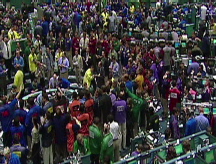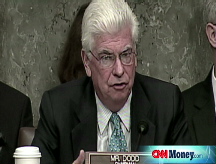Oil pulls back on weak demand
Futures lose traction on inventory report. Investors weigh weakness in crude and gasoline stockpiles with continued soft demand.

NEW YORK (CNNMoney.com) -- Oil prices slipped Wednesday, in a rocky session, as a government report showed weaker year-over-year demand and record-low gasoline supplies and refinery utilization.
In addition, the oil market has been waiting to hear the fate of a proposed $700 billion bailout plan for beleaguered financial services companies.
U.S. light crude for November delivery fell 88 cents to $105.73 a barrel on the New York Mercantile Exchange.
Oil had traded up $2.40 to $109.01 a barrel just prior to the report's release. Crude prices gave up gains after the report, as "demand readings trumped stock declines," wrote Linda Rafield, senior oil analyst at Platts, in a post-report statement.
The supply report "on the cover would certainly bolster the markets," said James Cordier, portfolio manager of OptionSellers.com. However, oil prices were lower because "people are looking ahead at slower economic growth in the U.S. and in Europe."
Demand slows: According to the Energy Information Administration's weekly supply report, oil products supplied over the last four-week period averaged 19.5 million barrels per day, 5.3% lower than the demand a year earlier.
"The largest part of the decline is due to the economic environment," said Amanda Kurzendoerfer, commodities analyst at Summit Energy. But she said Hurricanes Gustav and Ike also contributed to the drop in demand, with businesses closed and driving limited in the regions affected by the storms.
Rafield echoed the sentiment in her post-report statement. The 5.3% decline in demand for energy products "is a reflection of a distribution system that is not running at 100% following the hurricanes and not an actual indicator of end-consumption."
Drivers were still not hitting the road. Over the last four weeks, gasoline demand was 3.5% lower than the same period last year. And airlines were cutting back, too, as jet fuel demand was 4.5% lower. Demand for distillates fell 5.5%.
Gas stocks at record low: In the weekly inventory report, stockpiles of gasoline fell by 5.9 million barrels, more than the 5.1-million-barrel consensus estimate of industry analysts surveyed by Platts, a global energy information provider.
At 178.7 million barrels, gasoline stockpiles were at the lowest level since 1990, when the weekly supply data became available. It's the second straight week that stockpiles were at a record low.
Refineries operated at the lowest level on record in the week ended Sept. 19, according to EIA. Refineries turn crude oil into usable products, such as gasoline and heating oil. Refineries only operated at 66.7% of their operable capacity last week, which was even less than the 73.9% run-rate that analysts had forecast.
"Refining companies just don't want any inventory right now because they are expecting lower demand," said Cordier. "We are definitely trading futures and people are expecting demand to continue to come down."
Low inventories: Crude stocks decreased by 1.5 million barrels in the week ended Sept. 19. Analysts were looking for a gain of 1.6 million barrels of crude oil. At 290.2 million barrels, crude inventories were in the lower half of the average range for this time of year.
The continued decline in inventory levels keeps the market uneasy.
"There is a certain level of supply comfort that the market likes to see," said Kurzendoerfer. "Weak demand has mitigated some of that, but inventory levels have still declined very quickly."
Distillates, used to make heating oil and diesel fuel, fell by 4.2 million barrels and were in the lower half of the average range for this time of year. Analysts were looking for a decrease of only 1.8 million barrels.
Bailout plan: On Saturday, President Bush asked Congress for the authority to spend as much as $700 billion to purchase toxic mortgage debt from already struggling financial institutions in an effort to prevent the credit crisis from crippling an already beleaguered Wall Street. Congressional hearings were held Tuesday and Wednesday on the proposal.
If the bailout were passed and served to jumpstart the lethargic economy, the oil market hoped demand for energy would recover to healthy levels.
However, the fact that the economy is in need of a lifeline highlights just how weak it is, and raises fresh concerns about demand. A limping economy does not have a growing appetite for oil.
The bailout is "adding a lot of uncertainty to the picture," said Kurzendoerfer. "With that still up in the air, oil is having a hard time finding direction from it."
The plan involves a unprecedented shot of liquidity to the market and the sheer quantity of dollars being pumped into the market would devalue the greenback. Crude oil is traded in U.S. currency across the globe, so when the dollar loses value, crude prices increase.
Uncertainty about the bailout "really has frozen large volumes of trading," said Cordier. "A lot of people are taking a wait-and-see attitude on large bets in energy right now."
In the past couple of sessions, oil prices have zig-zagged, and the dollar's volatility has contributed to the movement in the price of oil.
Gulf struggles: The Gulf region was still working to regain footing after Hurricanes Gustav and Ike smashed the Gulf of Mexico and the Texas Gulf Coast, damaging production rigs and shuttering refineries.
The Minerals Management Service reports that 23 manned oil platforms have been destroyed by Hurricane Ike. Of the 694 remaining platforms, 203 production platforms, or 29.3%, were still evacuated.
According to the most recent situation report from the Department of Energy, 66.8% of production in the region remained shut in and 61.6% of natural gas production was still shuttered. With 5 refineries in Texas still shut down, nearly 1.2 million barrels per day less oil have been processed in the region, according to the DOE. ![]()





